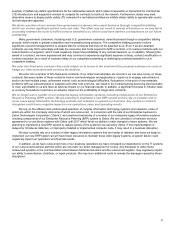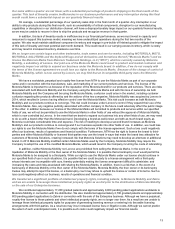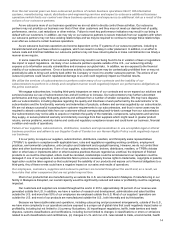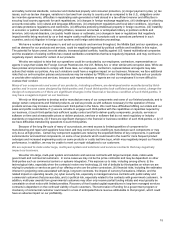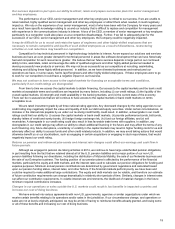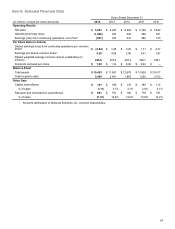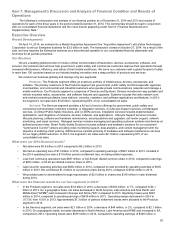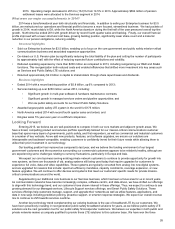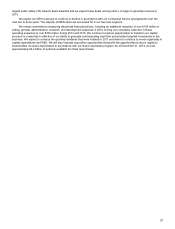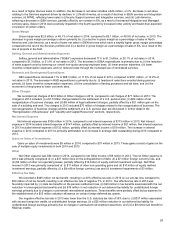Motorola 2014 Annual Report Download - page 22
Download and view the complete annual report
Please find page 22 of the 2014 Motorola annual report below. You can navigate through the pages in the report by either clicking on the pages listed below, or by using the keyword search tool below to find specific information within the annual report.20
We are subject to a wide range of product regulatory and safety, consumer, worker safety and environmental laws that
continue to expand and could impact our ability to grow our business, could subject us to unexpected costs and
liabilities and could impact our financial performance.
Our operations and the products we manufacture and/or sell are subject to a wide range of product regulatory and safety,
consumer, worker safety and environmental laws. Compliance with such existing or future laws could subject us to future costs
or liabilities, impact our production capabilities, constrict our ability to sell, expand or acquire facilities, restrict what products and
services we can offer, and generally impact our financial performance. Some of these laws are environmental and relate to the
use, disposal, clean up of, and exposure to certain substances. For example, in the U.S., laws often require parties to fund
remedial studies or actions regardless of fault and often times in response to action or omissions that were legal at the time they
occurred. We continue to incur disposal costs and have ongoing remediation obligations. Changes to environmental laws or our
discovery of additional obligations under these laws could have a negative impact on our financial performance.
Laws focused on: (i) the energy efficiency of electronic products and accessories, (ii) recycling of both electronic products
and packaging, (iii) reducing or eliminating certain hazardous substances in electronic products, (iv) and the transportation of
batteries continue to expand significantly. Laws pertaining to accessibility features of electronic products, standardization of
connectors and power supplies, the transportation of lithium-ion batteries and other aspects of our products are also
proliferating. There are also demanding and rapidly changing laws around the globe related to issues such as product safety,
radio interference, radio frequency radiation exposure, medical related functionality, and consumer and social mandates
pertaining to use of wireless or electronic equipment. These laws, and changes to these laws, could have a substantial impact
on whether we can offer certain products, solutions and services, on product costs, and on what capabilities and characteristics
our products or services can or must include.
These laws could impact our products and negatively affect our ability to manufacture and sell products competitively. We
expect these trends to continue. In addition, we anticipate that we will see increased demand to meet voluntary criteria related to
reduction or elimination of certain constituents from products, increasing energy efficiency, and providing additional accessibility.
We may be unable to obtain components and parts that are verified to be Democratic Republic of Congo ("DRC")
Conflict Free, which could result in reputational damage if we disclose that our products include minerals that have
been identified as “not found to be DRC conflict free” or if we disclose that we are unable to determine whether such
minerals are included in our products.
The Dodd-Frank Wall Street Reform and Consumer Protection Act included disclosure requirements regarding the use of
tin, tantalum, tungsten and gold (which are defined as “conflict minerals”) in our products and if the origin of these materials were
from the DRC or an adjoining country. If the minerals originated from the DRC or an adjoining country then a company must
disclose the measures it has taken to exercise due diligence and chain of custody to prevent the sourcing of such minerals that
have been found to be financing conflict in the DRC. There is a limited pool of suppliers who can provide verifiable DRC Conflict
Free components and parts, particularly since our supply chain is complex. As a result, we may be required to publicly disclose
that we are not currently able to determine if the products we manufactured in 2014 are DRC Conflict Free. For future reporting
years, if the industry systems that we are relying on are not mature enough for us to make a definitive Conflict Free
determination, we may have to declare our products as “not found to be DRC conflict free,” or such other definitional standard as
determined by the SEC and/or the judicial system and we may face reputational challenges with our customers, other
stockholders and the activist community as a result. In addition the European Union is in the process of drafting conflict minerals
legislation which may have an impact on our reporting obligations and compliance programs in Europe.
Item 1B: Unresolved Staff Comments
None.
Item 2: Properties
Motorola Solutions' principal executive offices are located at 1303 East Algonquin Road, Schaumburg, Illinois 60196.
Motorola Solutions also operates manufacturing facilities and sales offices in other U.S. locations and in many other countries.
As of December 31, 2014, we: (i) owned 10 facilities (manufacturing, sales, service and office), seven of which were
located in North America and three of which were located in other countries; (ii) leased 157 facilities, 60 of which were located in
North America and South America and 97 of which were located in other countries; and (iii) primarily utilized five major facilities
for the manufacturing and distribution of our products, located in: Penang, Malaysia; Schaumburg, Illinois; Elgin, Illinois; Berlin,
Germany; and Reynosa, Mexico.
We generally consider the productive capacity of our manufacturing facilities to be adequate and sufficient for our
requirements. The extent of utilization of each manufacturing facility varies throughout the year.
In 2014, a substantial portion of our products were manufactured in facilities in our owned facilities in Malaysia, Illinois, and
Mexico. Approximately 25% of our manufacturing, based on volume, is done by a small number of non-affiliated electronics
manufacturing suppliers and distribution and logistics services providers, most of which are outside the U.S. We rely on these
third-party providers in order to enhance our ability to lower costs and deliver products that meet demand. If manufacturing in
Malaysia, Illinois, or by third-parties were disrupted, our overall productive capacity could be significantly reduced.
Item 3: Legal Proceedings
We are a defendant in various suits, claims and investigations that arise in the normal course of business. In the opinion of
management, the ultimate disposition of our pending legal proceedings will not have a material adverse effect on our



